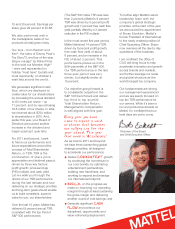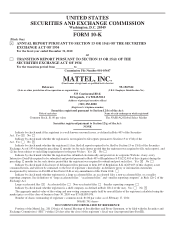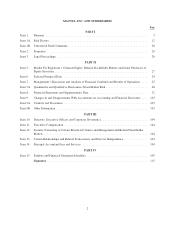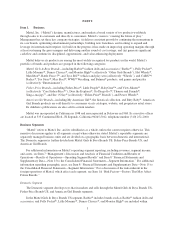Mattel 2010 Annual Report Download - page 15
Download and view the complete annual report
Please find page 15 of the 2010 Mattel annual report below. You can navigate through the pages in the report by either clicking on the pages listed below, or by using the keyword search tool below to find specific information within the annual report.Additionally, independent toy designers and developers bring concepts and products to Mattel and are
generally paid a royalty on the net selling price of products licensed to Mattel. These independent toy designers
may also create different products for other toy companies.
Advertising and Marketing
Mattel supports its product lines with extensive advertising and consumer promotions. Advertising takes
place at varying levels throughout the year and peaks during the traditional holiday season. Advertising includes
television and radio commercials, and magazine, newspaper, internet advertisements, and social media.
Promotions include in-store displays, sweepstakes, merchandising materials, and major events focusing on
products and tie-ins with various consumer products companies.
During 2010, 2009, and 2008, Mattel incurred expenses of $647.3 million (11.1% of net sales), $609.8
million (11.2% of net sales), and $719.2 million (12.2% of net sales), respectively, for advertising and
promotion.
Sales
Mattel’s products are sold throughout the world. Products within the Domestic segment are sold directly to
retailers, including discount and free-standing toy stores, chain stores, department stores, other retail outlets, and,
to a limited extent, wholesalers by Mattel Girls & Boys Brands US and Fisher-Price Brands US. Mattel also
operates several small retail outlets, generally near or at its corporate headquarters and distribution centers as a
service to its employees and as an outlet for its products. American Girl Brands products are sold directly to
consumers and its children’s publications are also sold to certain retailers. Mattel has nine retail stores,
American Girl Place®in Chicago, Illinois, New York, New York, and Los Angeles, California, and
American Girl®stores in Alpharetta, Georgia, Dallas, Texas, Natick, Massachusetts, Bloomington, Minnesota,
Lone Tree, Colorado, and Overland Park, Kansas, each of which features children’s products from the American
Girl Brands segment. American Girl Brands also has a retail outlet in Oshkosh, Wisconsin that serves as an outlet
for its products. Products within the International segment are sold directly to retailers and wholesalers in most
European, Latin American, and Asian countries, and in Australia, Canada, and New Zealand, and through agents
and distributors in those countries where Mattel has no direct presence. Mattel also has retail outlets in Latin
America and Europe that serve as outlets for its products. Additionally, Mattel sells certain of its products online
through its website.
During 2010, Mattel’s three largest customers (Wal-Mart at $1.1 billion, Toys “R” Us at $0.8 billion, and
Target at $0.5 billion) accounted for approximately 41% of worldwide consolidated net sales in the aggregate.
Within countries in the International segment, there is also a concentration of sales to certain large customers that
do not operate in the US, none of which exceed 10% of net sales. The customers and the degree of concentration
vary depending upon the region or nation. See Item 1A “Risk Factors—Factors That May Affect Future Results”
and Item 8 “Financial Statements and Supplementary Data—Note 15 to the Consolidated Financial Statements—
Segment Information.”
Licenses and Distribution Agreements
Mattel has license agreements with third parties that permit Mattel to utilize the trademark, characters, or
inventions of the licensor in products that Mattel sells. A number of these licenses relate to product lines that are
significant to Mattel’s business and operations.
Mattel has entered into agreements to license entertainment properties from, among others, Disney
Enterprises, Inc. (including Disney®characters such as Disney Princess™, CARS™ and Toy Story®from Pixar,
High School Musical®, Winnie the Pooh®, and all Disney®films and television properties for use in Mattel’s
games), Viacom International, Inc. relating to its Nickelodeon®properties (including Dora the Explorer®,Go
Diego Go!®, and SpongeBob SquarePants®), Warner Bros. Consumer Products (including Batman®, Superman®,
7
























